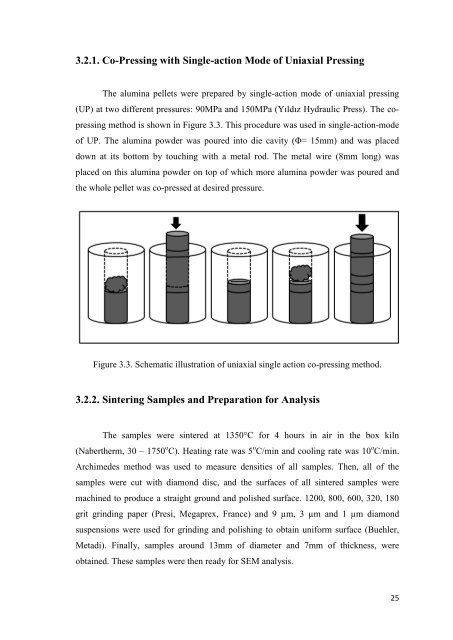use of metal templates for microcavity formation in alumina
use of metal templates for microcavity formation in alumina
use of metal templates for microcavity formation in alumina
Create successful ePaper yourself
Turn your PDF publications into a flip-book with our unique Google optimized e-Paper software.
3.2.1. Co-Press<strong>in</strong>g with S<strong>in</strong>gle-action Mode <strong>of</strong> Uniaxial Press<strong>in</strong>g<br />
The alum<strong>in</strong>a pellets were prepared by s<strong>in</strong>gle-action mode <strong>of</strong> uniaxial press<strong>in</strong>g<br />
(UP) at two different pressures: 90MPa and 150MPa (Yıldız Hydraulic Press). The co-<br />
press<strong>in</strong>g method is shown <strong>in</strong> Figure 3.3. This procedure was <strong>use</strong>d <strong>in</strong> s<strong>in</strong>gle-action-mode<br />
<strong>of</strong> UP. The alum<strong>in</strong>a powder was poured <strong>in</strong>to die cavity (Φ= 15mm) and was placed<br />
down at its bottom by touch<strong>in</strong>g with a <strong>metal</strong> rod. The <strong>metal</strong> wire (8mm long) was<br />
placed on this alum<strong>in</strong>a powder on top <strong>of</strong> which more alum<strong>in</strong>a powder was poured and<br />
the whole pellet was co-pressed at desired pressure.<br />
Figure 3.3. Schematic illustration <strong>of</strong> uniaxial s<strong>in</strong>gle action co-press<strong>in</strong>g method.<br />
3.2.2. S<strong>in</strong>ter<strong>in</strong>g Samples and Preparation <strong>for</strong> Analysis<br />
The samples were s<strong>in</strong>tered at 1350°C <strong>for</strong> 4 hours <strong>in</strong> air <strong>in</strong> the box kiln<br />
(Nabertherm, 30 – 1750 o C). Heat<strong>in</strong>g rate was 5 o C/m<strong>in</strong> and cool<strong>in</strong>g rate was 10 o C/m<strong>in</strong>.<br />
Archimedes method was <strong>use</strong>d to measure densities <strong>of</strong> all samples. Then, all <strong>of</strong> the<br />
samples were cut with diamond disc, and the surfaces <strong>of</strong> all s<strong>in</strong>tered samples were<br />
mach<strong>in</strong>ed to produce a straight ground and polished surface. 1200, 800, 600, 320, 180<br />
grit gr<strong>in</strong>d<strong>in</strong>g paper (Presi, Megaprex, France) and 9 µm, 3 µm and 1 µm diamond<br />
suspensions were <strong>use</strong>d <strong>for</strong> gr<strong>in</strong>d<strong>in</strong>g and polish<strong>in</strong>g to obta<strong>in</strong> uni<strong>for</strong>m surface (Buehler,<br />
Metadi). F<strong>in</strong>ally, samples around 13mm <strong>of</strong> diameter and 7mm <strong>of</strong> thickness, were<br />
obta<strong>in</strong>ed. These samples were then ready <strong>for</strong> SEM analysis.<br />
25

















